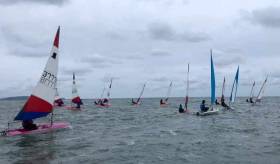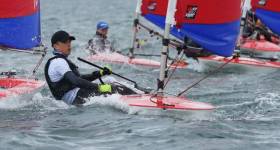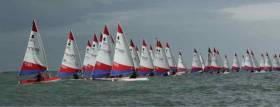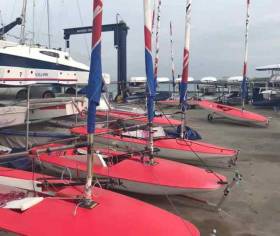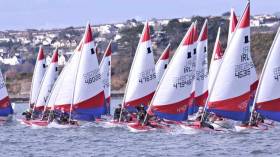Displaying items by tag: Topper
Daniel Palmer Leads Toppers at Ballyholme Yacht Club
A brisk northerly breeze met the Topper sailors on Saturday afternoon for a cold day of sailing in what was otherwise perfect sailing weather for the fourth week of the Charles Hurst Jaguar Land Rover Ballyholme Yacht Club Junior Icebreaker Series.
Race one, in what now seems to be predictable, saw Daniel Palmer with a perfectly timed run to the pin at the start take a commanding lead on the first beat which he never looked like relinquishing. The chasing pack was led by Katie Brow, Dan Sherriff, Henry Nelson and Joseph Robinson in that order. The beat to the finish was light and shifty which allowed Dan to overtake Katie just on the line with the others crossing in sequence.
At the end of the first beat of race two, it was Katie leading from Daniel with last year’s winner Faye McCartan in third and that is how they finished. Rex Claney deserves a mention for pulling up to eighth in the race after a capsize and subsequent swim at the start!
With the cool temperatures taking their toll on the fleet (and coaches) the third race saw the windward mark moved further south to shorten the course. True to form Daniel took line honours in the race with Dan in second. Katie took her third podium place of the day and is now firmly in second place overall. Joseph Robinson had his best race of the day in fourth and Faye’s fifth-place saw a consistent day for her too.
Overall after Daniel and Katie, Romy’s good run of form sees her in third overall with Henry in fourth and Joseph in fifth. Evie Pringle’s sixth in the last race of the day along with her previous race win now see her sixth overall.
Topper Ireland Publish 2020 Fixtures Calendar
Following a very successful year in 2019 where almost all events saw increased numbers and an overall increase of almost 10% from 2018, Topper Ireland will be returning to some of our regular locations for racing in 2020, but have a few new locations to add to the challenge writes Joseph Seymour, Chairman of Topper Ireland.
The start of the year will see its first Championship event of the year at Royal Cork Yacht Club where we will help our biggest Topper Fleet celebrate this momentous year for their Club. We will then continue to switch north and south across the island for our Traveller events with our second Championship event at Royal North of Ireland Yacht Club, followed a few weeks later by our premier event the Topper Nationals.
For the first time, we will be holding this event in Lough Derg Yacht Club, and we look forward to welcoming the ITCA GB/RYA Squad to this event to increase the competition before our sailors go to the Worlds.
 The Topper Ireland 2020 calendar
The Topper Ireland 2020 calendar
The Topper Worlds will be held in Lake Garda this year with a large fleet expected to travel from Ireland again. On the return from their travels, our sailors will then close out the year with our first visit to Courtown Sailing Club and our last Championship event of the Year, the Finale, at East Antrim Boat Club. For the first time, our 2021 competition year will kick off almost immediately with our first Traveller in September 2020.
Royal Cork Yacht Club Laser & Topper Frostbites Underway in Cork Harbour
After three races of the Royal Cork Yacht Club Laser 4.7 Frostbites, Dawson Kohl leads from Peter Layton in a 16-boat fleet. Third is Daisy Seward writes Bob Bateman
In the Laser Radial division, Chris Bateman leads Atlee Kohl with Sophie Crosbie in third in the seven boat fleet.
A 12-boat Topper 5.3 fleet is lead by Neil O'Leary with Darragh Collins in second and Cian Mc Donagh third.
See photo gallery below. Results are here.

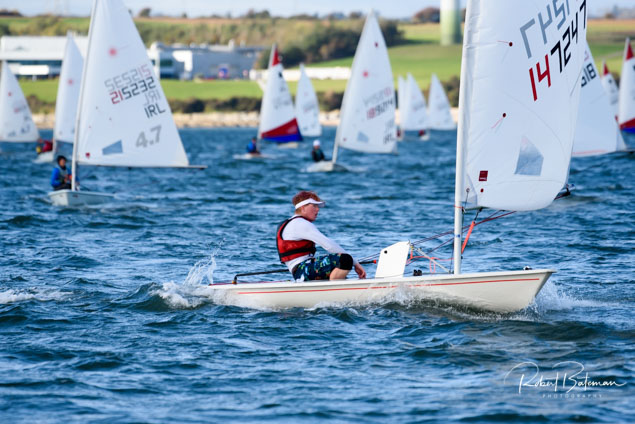
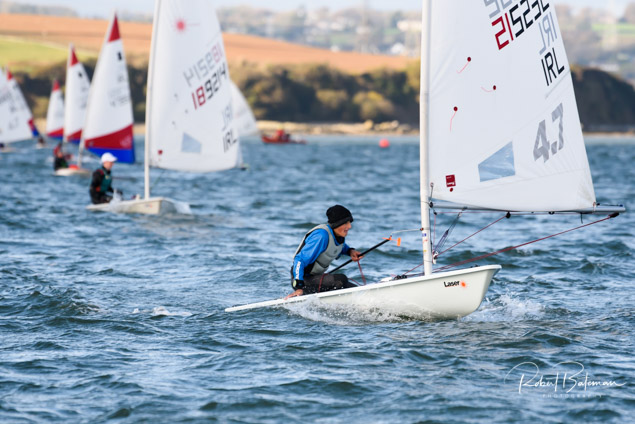
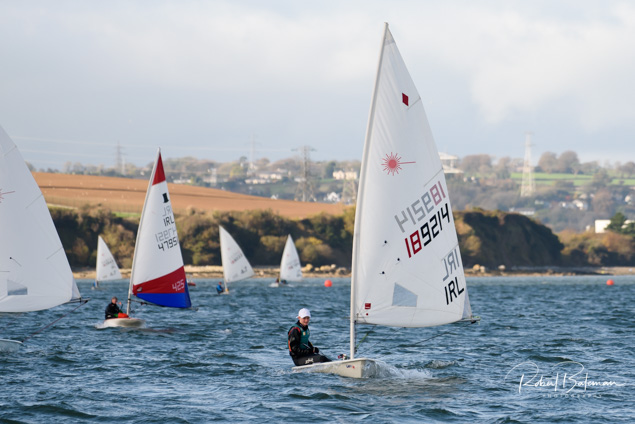

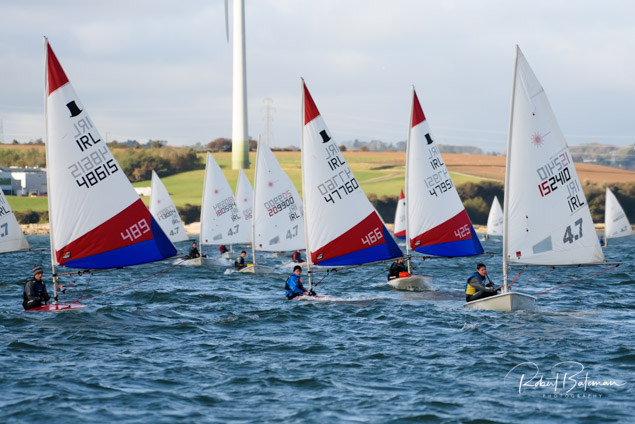


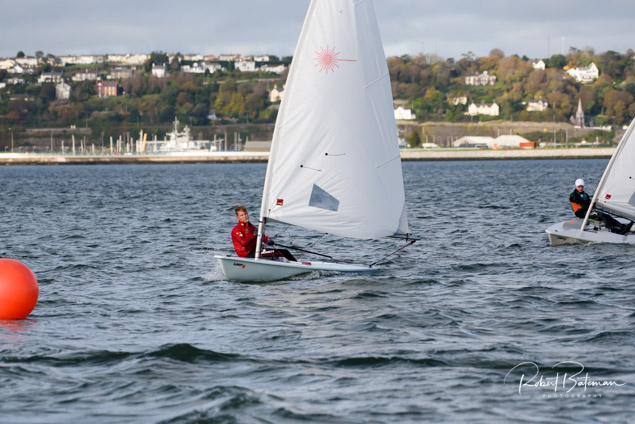
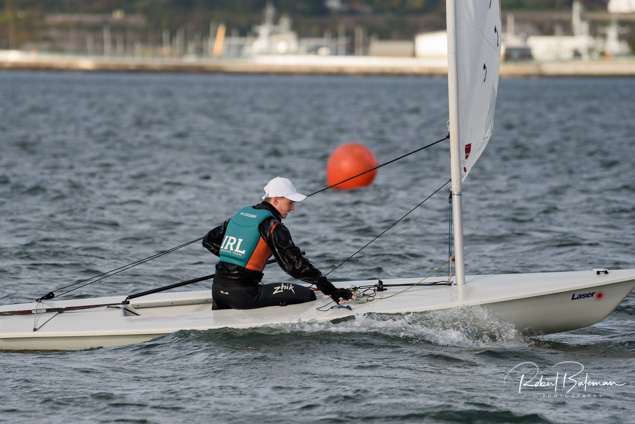

Nine Topper 4.2 Race Wins for Rian Collins of Royal Cork
The Topper Ireland Nationals were held at the Royal North of Ireland Yacht Club on the banks of Belfast Lough last weekend writes Joe Seymour. Over 50 sailors from all parts of Ireland and 10 from the ITCA (GBR) / RYA British Youth Sailing Team were in attendance making it a highly competitive event. While the winds were not strong they were constant over the 3 days and 9 good races were completed.
In the 4.2 fleet, Rian Collins of Royal Cork continued his winning streak with 9 bullets over the 3 days. In the 5.3 fleet the wins were spread out between the top 4 sailors, with Tim Evans (Grafham Water SC) emerging as the Overall Winner, followed by Hugh Lynch (RCYC, pictured above) who was second and overall Irish Champion. Hannah Dadley-Young (Ballyholme YC) finished as First Lady and sixth overall in another impressive performance for this Junior Sailor, which included two second finishes.
RNIYC put on an impressive show for all the visitors with over 60 volunteers ensuring that the event went off without a hitch.
Topper racing now relocates to the Medemblik in the Netherlands for the Topper World Championship on the 22 to 26 July. Over 20 Irish sailors will be participating, and boats are already on the move to Holland with sailors arriving next week. We look forward to reporting on their progress in the coming weeks.
Joe Seymour is Topper Ireland Chairperson
Good Weekend for Topper Sailors at Dunmore East
The Topper Ireland Southern Championships were held in Waterford Harbour Sailing Club in Dunmore East this past weekend, 22-23rd June.
59 competitors sailed six races over the course of the weekend in varying conditions - from beautiful sun and nice brisk sailing winds on Saturday – where the organisers managed to get 4 races in, to heavy rain and a big swell on Sunday to make it much more challenging for the final 2 races.
WHSC did a great job of making the sailors welcome and had a fantastic team of volunteers available both in and around the club itself, and also around the roads to direct visitors around the roadworks. They hosted a BBQ in the Club on Saturday night, which was enjoyed by many of those visitors.
It was also great to see so many sailors who are new to the Topper fleet competing in the championships, including new young sailors in the established clubs and also many sailors from smaller clubs who have not been active in Toppers for the past few years. The prizes were spread across the Country, but particular mention of the Collins Brothers from RCYC, Rian winning the 4.2 fleet and Darragh winning the 5.3 Fleet, and Hannah Dadley (Ballyholme YC) who was First Lady and is still in the junior age category.
The Closing Date for our premier event of the year, the 3-day National Championship, is 28th June. This is to be held at the Royal North of Ireland Yacht Club, Holywood, Co. Down on the following weekend of 5-7th July, with boats from throughout Ireland and some of the top sailors from the UK expected to be in attendance.
As Afloat.ie previously reported, fifty keen junior sailors from all four provinces took to the waters of Dubin Bay over the weekend as the National Yacht Club, with the support of Viking Marine, hosted Topper Ireland’s third annual Winter Regatta writes Jo Seymour.
Despite heavy overnight winds the wind dropped off as Saturday morning progressed, allowing the sailors to take to the water for Eddie Totterdell to oversee 3 clean races over both the full rig and 4.2 rig fleets, in spite of the wind dropping off at times, and shifting more than 90 degrees (meaning that, after small adjustments by the mark layers between races 1 and 2, a full reset of the course was needed for the final race).
On Sunday the Spring Chicken sailors headed to the Muglins in murky conditions, but it lifted to allow the Toppers a clear race area back off Seapoint. While the first race went off on time, the wind came up earlier than expected and the visibility dropped again so racing was abandoned to bring the sailors to shore. But once hot chocolate, warm showers and food was dished out, the smiles were back and there was a great level of chatter around the deck of the NYC as various fleets of sailors mingled as they waited for the prize giving. A bucket on the table raised a nice donation for the local RNLI station as well.
Prizes went all around the country, and included perpetual trophies for the top sailors – Eoin Horgan (RCYC) in the Youth Male, Emma O’Sullivan (RCYC) in the Youth Female and Charlie Patterson (East Antrim Boat Club) in the overall 4.2 categories. But overall it was a great first gathering of the friendly Topper Community, hoping for a great sailing year ahead. The next event is the first “Traveller” in Quoile Yacht Club, Downpatrick on Sunday 14th April and we are all looking forward to that.
Full results are downloadable here.
Royal Cork Sailors on Top at Topper Winter Regatta at National Yacht Club
The Viking Marine sponsored Topper Winter Regatta at the National Yacht Club in Dun Laoghaire attracted a record turnout for a four-race, one discard event. As Afloat.ie previously reported, sailors attended from across Ireland.
In the 43-boat Topper Full rig class, Royal Cork Yacht Club youth sailors made a clean sweep of the podium. Eoin Horgan beat Cillian Foster by a single point for the overall title with Emma O'Sullivan in third place.
In the 4.2 class, Charlie Patterson from East Antrim Boat Club took the honours in a seven-boat fleet from Clontarf Yacht & Boat Club's Ella Fitzgerald.
Download full results below.
Viking Marine Winter Topper Regatta Set for Record Fleet Size at National Yacht Club
With sailors coming from all over Ireland and a favourable weather forecast, Irish Topper agent Viking Marine is sponsoring this weekend's Winter Youth sailing event hosted by the National Yacht Club in Dun Laoghaire.
With up to 50 young sailors expected, it clearly shows the popularity of this pathway boat especially amongst sailors transitioning out of the Optimist class, Viking's Ian O'Meara told Afloat.ie.
"Up to 50 young sailors expected"
‘We have had great success with all boats across the Topper range and Topper are a world-class company to work with,’ O Meara says. ‘Great boats, great back up and service and constant innovation as seen with the new 6:1 kicker upgrade kit. Sailors are loving this recent innovation from Topper giving the kicker far greater power’.
Viking Marine is open all weekend with sales assistants Conor and Saoirse on hand to assist competitors and families in need of Topper equipment and kit
Young Irish Topper Sailors Head For China
It’s great to see young sailors enthusiastic about the sport. Watching Topper dinghy sailors training for their big challenge, with determination and focus, is encouraging. The sport has a future if it can hold onto young sailors.
This weekend young sailors of the 11-foot Topper dinghy from Cork, Dublin and Northern Ireland, will set off on the biggest challenge of their lives so far – heading to China to race in the World Topper Championships.
The boat was designed by Ian Proctor and has gained popularity around the world.
Two hundred and sixty-five sailors from twenty-one countries will be competing at the Topper World Championships. The Great Britain Team are sending 65 sailors and amongst the other countries participating will be France, Italy, Hawaii, Germany and a strong contingent from China where the boat has become very popular in the past few years.
The Royal Cork Yacht Club at Crosshaven has 35 Toppers which, its Class Captain says, is the biggest Topper dinghy fleet in Europe. The club is sending a team of fifteen of these young sailors to the Topper World Championships in China, which will be sailed next week. Another 14 Topper sailors are due to travel from Dublin and Northern Ireland clubs.
Diarmuid Lynch is the Class Captain and says their involvement at the World Championships in China will be a good representation of Ireland by young Irish sailors.
The Royal Cork will have the largest club representation and for this week’s Podcast, Diarmuid Lynch has been telling me that it is a great challenge for the young sailors who are hoping to achieve good results for Ireland.
• Listen to the podcast below
Topper Class Appeals For Parents To Join Committee
#Topper - The Irish Topper Class Association is appealing for parents of class members to join its committee for 2018-19.
“Every year, as sailors move on to other classes, so do most of the parents who have served on the committee,” said the class in a statement on social media.
“The class only exists because of parental support, so if you feel you would like to help next season, please chat to any of the committee members or drop an email to Nicola at [email protected].
“For the majority of positions, you do not need any sailing knowledge, just a willingness to help.”


























